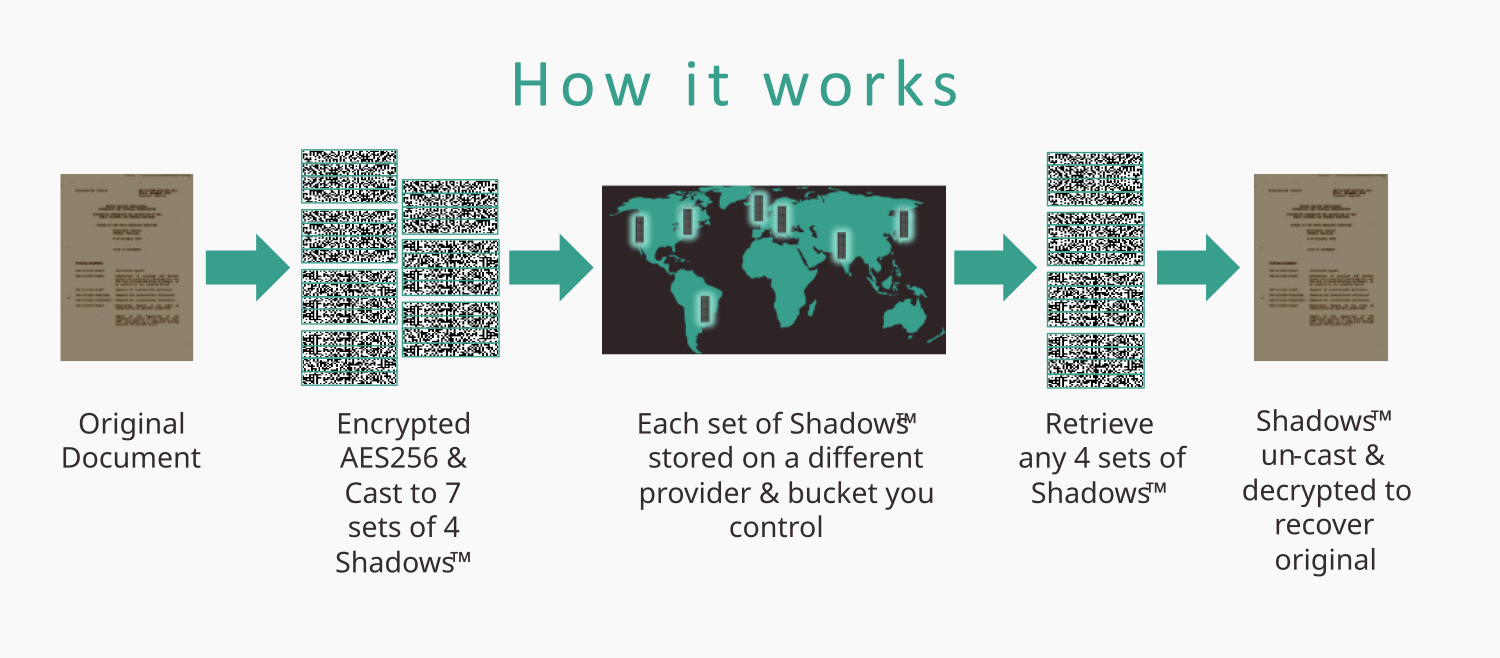Frequently Asked Questions
We're happy to answer any questions you may have. If you don't find the answer here please use this contact form and we'll be delighted to help.
Thank you
Security
How can you be certain that the shadows are undecryptable?
There is a mathematical proof of this; but it can be understood in simple terms by understanding that the Shadows don't “contain” any of the original data. Instead they are mathematical derivations from the original. Each is only a quarter the size of the original; and changing any byte of the original changes every shadow. That means you must have four of the shadows just to have sufficient information to start a decryption effort.
It's related to the way that simultaneous equations work; if you have fewer equations than variables, you can't solve those equations.
Umbra has engaged with the University of Manchester to gain independent confirmation of the security:
Umbra has engaged with the University of Manchester to gain independent confirmation of the security:
[With Umbra's approach] when a message or file is shared in 7 shares and at least 4 shares are required for reconstruction, no information about the message is leaked (in an information theoretical sense) if fewer than 4 shares are known.
Will quantum computing render the protection vulnerable
No. The security is not guaranteed using encryption alone. An attacker obtaining 3 shadows lacks enough information to start a decryption effort, regardless of the methodology or computing power available.
Without Umbra, what are the chances my company experiences a data breach?
Last year 39% of enterprises experienced a breach in their cloud systems. ShadowStream helps ensure no data is lost or falls into the wrong hands.
What is ShadowStream’s three fault tolerance?
Three fault tolerance means up to three cloud storage providers can be down, lost, or otherwise inaccessible before disruption to service.
My provider promises 99.9999% uptime. Why would I need any more assurance?
While some providers such as AWS claim to have a 99.9999% guaranteed uptime, there are countless exceptions listed in SLAs. Only a handful of users who follow best practice guides to the letter come close to achieving these results. Additionally, providers are only legally required to give a level of security defined as “reasonable.” This still leaves substantial room for error.
I keep backups, surely that means I'm safe if my data gets lost or deleted?
Unfortunately not. Whilst keeping backups is strongly recommended for conventional storage methods, a breach, loss, or accidental deletion could still result in weeks of downtime for you or your client. For most companies this is simply not an option.
Does Umbra have copies of, or access to, my data?
No, Umbra does not store any of your data on-site, not even the encrypted shadows. The Shadows are stored on third party cloud providers you nominate and control. Umbra can use its extensive monitoring system to help give advice selecting suitable providers.
With Umbra Virtual On-Prem Umbra staff have no access to your data.
With Umbra Virtual On-Prem Umbra staff have no access to your data.
Implementation
Is ShadowStream compatible with my cloud storage provider?
Umbra is compatible with over 30 cloud object storage providers.
Can I use more than seven shadows?
Yes, If you are looking for even greater resilience it is possible to split data into additional shadows. See on-premises storage below…
Can I use Umbra with on-premise storage?
Storing shadows locally is indeed supported. This can deliver better latency but you might want to design the system so that 4 shadows are kept off-site. For instance, a 4+5 approach ensures that you can stand your premises and 1 external source being doing without losing access, but most read requests can be fulfilled from local storage.
Will I experience downtime during migration?
Umbra ShadowStream™ implements the AWS S3 API so is a drop in enhancement for web applications using AWS or any of their compatible equivalent services. Migration can be as simple as switching out credentials.
Is there a limit to how much data I can store through ShadowStream?
The only limit on data would be the amount supported by providers such as AWS and Azure, meaning there would be no decrease in the amount of data you could potentially store.
How much more does this cost?
For most users, the total cost can reduce. Your system uptime and data security doesn't depend on the cloud providers, so you are free to pick from those that offer the best price/performance, saving much more than the cost of Umbra's service.
What's more storing the shadows requires 40% less total storage than using regional duplication and an offsite backup. So the total amount of data stored goes down, saving more money.
What's more storing the shadows requires 40% less total storage than using regional duplication and an offsite backup. So the total amount of data stored goes down, saving more money.
How performant is the system, is there a speed penalty?
Data writing is handled at around 1Gbit/second per server thread; so most applications are not limited by processing time.
Because we only need 4 shadows, we can avoid fetching slower shadows.
Most importantly, many services rely on client re-tries, extending the time to fetch content considerably. As we don't need the slowest three Shadows we can avoid retries.
Because we only need 4 shadows, we can avoid fetching slower shadows.
Most importantly, many services rely on client re-tries, extending the time to fetch content considerably. As we don't need the slowest three Shadows we can avoid retries.
If we change our minds can we leave Umbra?
Of course. We provide an "Parallel" option you can use to return to your old provider instantly as we will continue to send data to your old provider simultaneously. Once you're comfortable with Umbra you can simply switch that off and save the storage costs.
How can I get Umra for me or my client?
Fill out this form and we'll be in touch!
